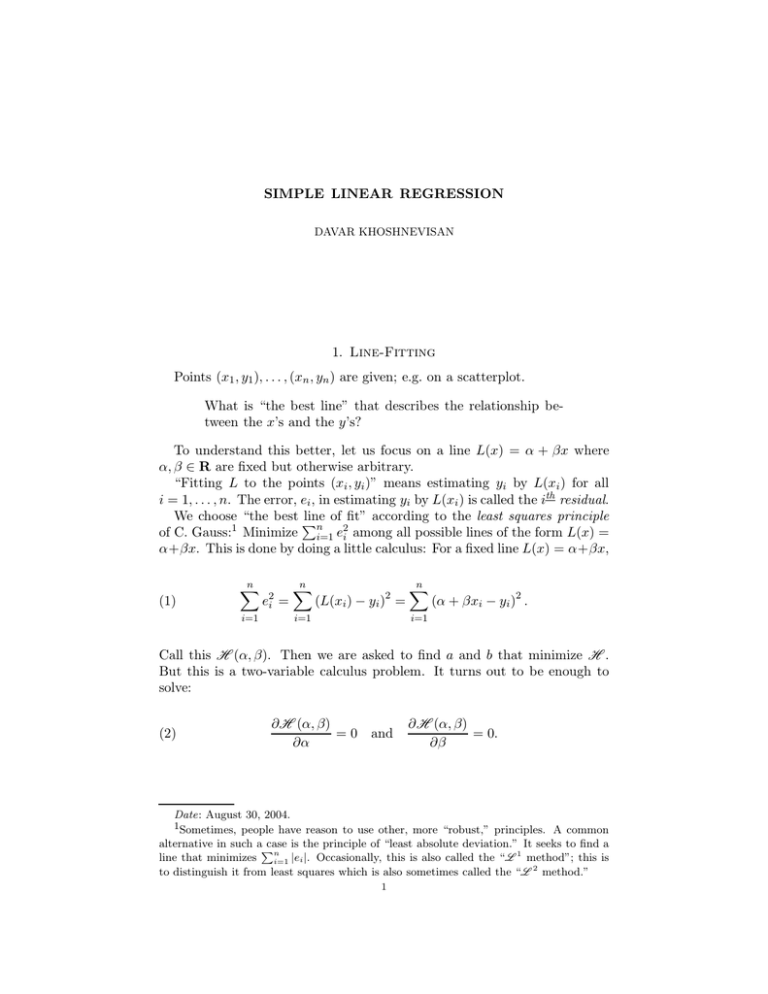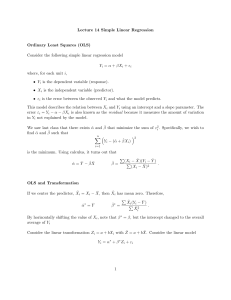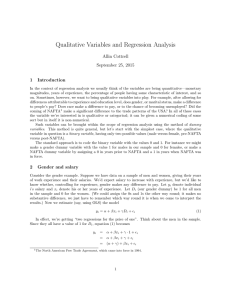SIMPLE LINEAR REGRESSION 1. Line-Fitting Points ( )
advertisement

SIMPLE LINEAR REGRESSION DAVAR KHOSHNEVISAN 1. Line-Fitting Points (x1 , y1 ), . . . , (xn , yn ) are given; e.g. on a scatterplot. What is “the best line” that describes the relationship between the x’s and the y’s? To understand this better, let us focus on a line L(x) = α + βx where α, β ∈ R are fixed but otherwise arbitrary. “Fitting L to the points (xi , yi )” means estimating yi by L(xi ) for all i = 1, . . . , n. The error, ei , in estimating yi by L(xi ) is called the ith residual. We choose “the best P line of fit” according to the least squares principle of C. Gauss:1 Minimize ni=1 e2i among all possible lines of the form L(x) = α+βx. This is done by doing a little calculus: For a fixed line L(x) = α+βx, n X (1) i=1 e2i = n X (L(xi ) − yi )2 = i=1 n X (α + βxi − yi )2 . i=1 H H Call this (α, β). Then we are asked to find a and b that minimize . But this is a two-variable calculus problem. It turns out to be enough to solve: (2) ∂ H (α, β) = 0 ∂α and ∂ H (α, β) = 0. ∂β Date: August 30, 2004. 1Sometimes, people have reason to use other, more “robust,” principles. A common alternative in such aP case is the principle of “least absolute deviation.” It seeks to find a 1 line that minimizes n method”; this is i=1 |ei |. Occasionally, this is also called the “ to distinguish it from least squares which is also sometimes called the “ 2 method.” L 1 L 2 DAVAR KHOSHNEVISAN First, ∂ H (α, β) = X 2(α + βx − y ) n ∂α i i=1 = 2αn + 2β (3) ∂ n X i xi − 2 i=1 n X H (α, β) = X 2(α + βx − y )x n ∂β i i=1 = 2α n X xi + 2β i=1 yi , and i=1 i n X i=1 i x2i − 2 n X xi y i . i=1 These are called the normal equations. Now (2) is transformed into two equations in two unknowns [α and β]: (4) αx + βx2 = xy α + βx = y. Multiply the second equation of (4) by x, and then subtract from the first equation to find that β(x2 − (x)2 ) = xy − x · y. You should recognize this, in statistical terms, as βVar(x) = Cov(x, y). Equivalently, β = Cov(x, y)/Var(x) = Corr(x, y)SDy /SDx . Plug this into the second equation of (4) to find that α = y − βx for the computed β. To summarize, Theorem 1.1. The least-squares line through (x1 , y1 ), . . . , (xn , yn ) is unique and defined by b − x), where βb = Corr(x, y) SDy . (5) L(x) = y + β(x SDx 2. The Measurement-Error Model Let Y = (Y1 , . . . , Yn ) be a random sample of n i.i.d. copies of the response variable. The measurement-error model posits the following: (6) Yi = α + βXi + εi i = 1, . . . , n. Here, X = (X1 , . . . , Xn ) is a non-random vector of constants—the explanatory variables—and α and β are unknown parameters. This model also assumes that the εi ’s are i.i.d. N (0, σ 2 ) for an unknown parameter σ > 0. The Yi ’s are random only because the εi ’s are (and not the Xi ’s). According to the principle of least squares (Theorem 1.1), the best leastsquares estimates of α and β are, respectively, 1 Pn i=1 Xi Yi − X · Y n b (7) β= 1P and α b =Y −α bX. n 2 i=1 (Xi − X) n The more imortant parameter is β. For instance, consider the test, (8) H0 : β = 0 vs. H1 : β 6= 0. SIMPLE LINEAR REGRESSION 3 This is testing the hypothesis that the explanatory variable X has a (linear) effect on Y . b Note that So we need the distribution of β. Pn n X i=1 Yi Xi − X b β = Pn = bi Y i , (9) 2 i=1 (Xi − X) i=1 where (10) Xi − X bi = ns2X for s2X n 1X = (Xi − X)2 . n i=1 Recall that the Xi ’s are not random. Therefore, neither are the bi ’s. Also recall, Lemma 2.1. If V1 , . . . ,P Vn are independent and Vi ∼ N (µi , σi2 ), then for all non-random c1 , . . . , cn , ni=1 ci Vi ∼ N (µ, σ 2 ) where µ = µ1 + · · · + µn and σ 2 = σ12 + · · · + σ22 . P P Consequently, βb ∼ N ( ni=1 bi E[Yi ], ni=1 b2i Var(Yi )). But Yi = α + βXi + 2 εi . So, E[Y and Var(Yi ) = Var(εi ) = is easy to check Pni ] = α + βXi , P Pσn . It n that: (i) i=1 bi = 0; (ii) i=1 bi Xi = 1; and (iii) i=1 b2i = 1/(ns2X ). This proves that 2 σ (11) βb ∼ N β, 2 . nsX b = β. That is, βb is an unbiased estimator of β. Moreover, Therefore, E[β] 2 if we knew σ , then we could perform the test of hypothesis (8) at any predescribed level, say at 95%. The trouble is that we generally do not know σ 2 . P Because the Yi ’s have variance σ 2 , we can estimate σ 2 by s2Y = n1 ni=1 (Yi − b s2 ). The key to this Y )2 . But then we need the joint distribution of (β, Y theory is that βb is independent of s2Y . We just determined the distribution b and we will see later on that the H0 -distribution of s2 is essentially of β, Y 2 χ . The rest will be smooth sailing. To recap, we need to accomplish two things: (1) Derive the independence of βb and s2Y ; and (2) Honestly compute the distribution of s2Y under H0 . Just about all of this semester’s work is concerned with accomplishing these two goals (for more general models).











